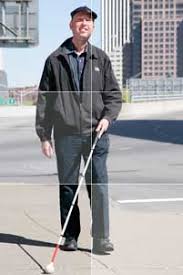
Blindness?
Blindness is defined as a loss of vision in both eyes that cannot be corrected to better than 10/100 feet or 6/60 meters. The term blindness also applies to loss of peripheral vision so that visual field is restricted to less than a 20 degree angle (tunnel vision). People who had sight but lost it are referred to as adventitiously or newly blinded, whereas people born without sight are said to be congenitally blind.
Cause
There are many possible causes of blindness: a detached retina, diabetic retinopathy, puncture wounds to the eyes, multiple sclerosis, conjunctivitis, retinal hemorage, retinal fibrosis, enucleation,glaucoma, pressure ob the optic nerve, or rubella.
Assessment
Areas
People with visual impairments frequently have multiple handicaps that need to be assessed and managed to improve coping skills.
- range of motion
- hand function and skills-grasp, pinch,and release
- muscle strength
- ambulation and mobility
- postural reflexes and balance/equilibrium reactions
- sensory awareness and discrimination
- auditory localization
- perceptual skills, including directionality and laterality
- self perception
- interpersonal skills
- self-care skills, including oral motor skills
- communication skills
- productivity interests and skills
- leisure interests and skills
Instruments
- Screening for physical and Occupational Therapy Referral
- Activities of daily living scale
- Occupational histiry
- Leisure checklist
Problems
Motor
- The person loses ease of mobility.
- Hand functions that normally rely on visual input are decreased.
Sensory
- The person has a loss of acuity.
- The person ha a los of color vision.
- The person may have no awareness of the environment.
- The person may have light perception only (awareness of light and dark).
- The person may have travel vision but cannot move safely about the environment independently.
Cognitive
Learning problems may occur for persons previosly dependent on sight for gaining most
of their information.
Intrapersonal
- The person has feelings of insecurity.
- The person has feelings of helplessness and hopelessness.
- The person may be depressed .
- The person may become introverted.
Interpersonal
- The person may become dependent to others.
- The person may avoid friends and situations previously enjoyed.
The person may have loss of skills that depend on vision, such as grooming, telling time,
or matching socks, skirt, and blouse.
Productivity
the person may be unable to continue a former occupation or need adjustments in the
working environment.
Leisure
The person may be unable to continue some leisure interests previously enjoyed or need
adjustments to continue them, such as stamp or coin collecting and reading.
Treatment/Management
Motor
- Help the person regain mobility.
- Provide practice in using hands in activities.
- Increase the person's skills and awareness of other sensory modalities, including hearing, touch, kinesthesia, proprioception, and vestibulum.
Inform the person of learning options available to the blind, including books on tape and music activities.
Intrapersonal
Improve self-perception through use of creative activities, such as crafts, drama, dance, or music activities.
Interpersonal
- Encourage the person's family to discuss role changes that may occur because of blindness and what roles the person can perform within the family structure.
- Encourage the person to participate in social activities.
Help the person to organize objects needed for activities of daily living, such as marking objects for easy identification and making use of Braille-coded objects, such as watches and timers.
Productivity
- Help the person determine whether previous employment or job interests are feasible with limited or no sight.
- Suggest changes that could be made in the work environment to facilitate continued employment for a person with limited sight.
- help the person explore alternate vocational interests if continuation of present emplotment is not possible.
- Help the person organize home living environment to facilitate management of it.
Help the person explore new or redevelop old interests adapted for blind persons, including materials that can be purchased, such as Braille-marked cards.
Precautions
- Safety is a major concern. Always check equipment and the physical environment for possible hazards.
- If blindness is due to diabetic retinopathy, be aware of other problems associated with diabetes, such as poor circulation and loss of tactile sensation.
- The person can demonstrate the ability to perform basic activities of daily living independently.
- The person is able to negotiate home and local community without assistance.
- The person is able to engage in productive activities as a worker, student or volunteer.
- The person participates in a variety of leisure activities.




